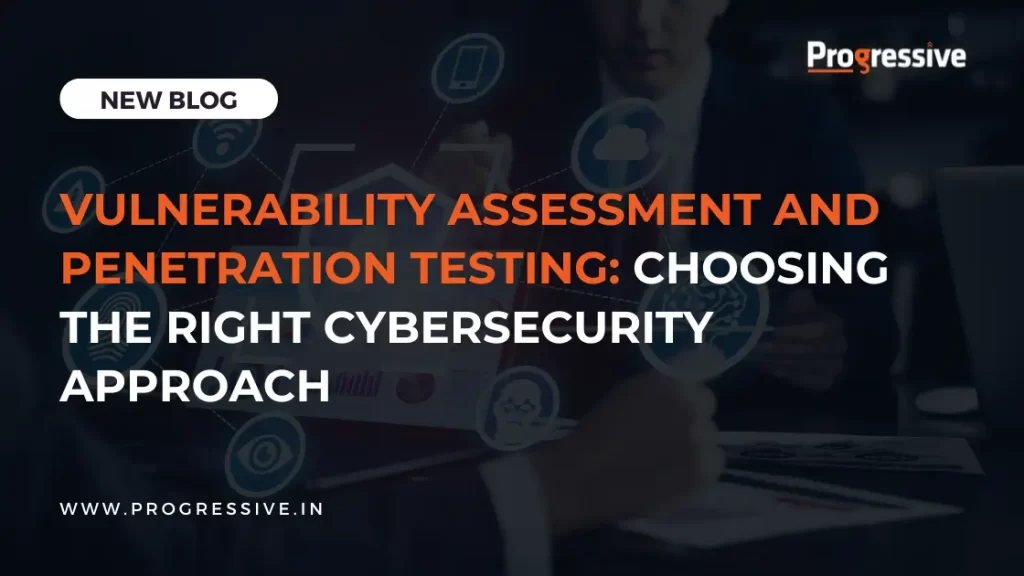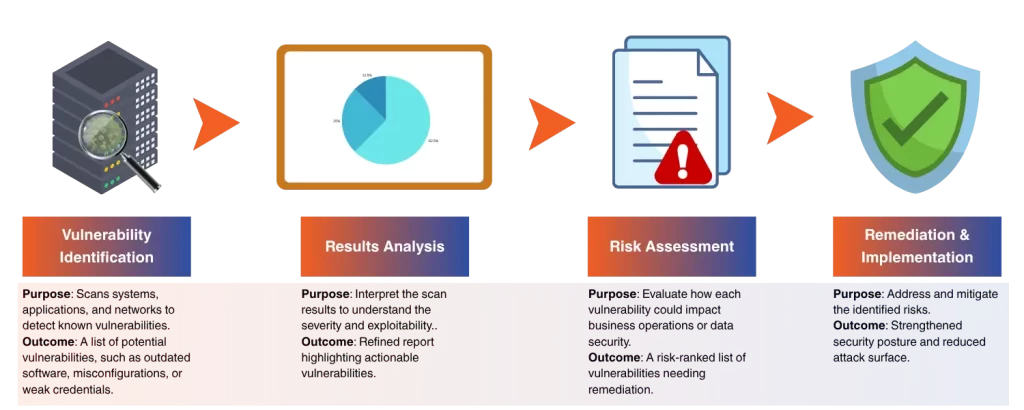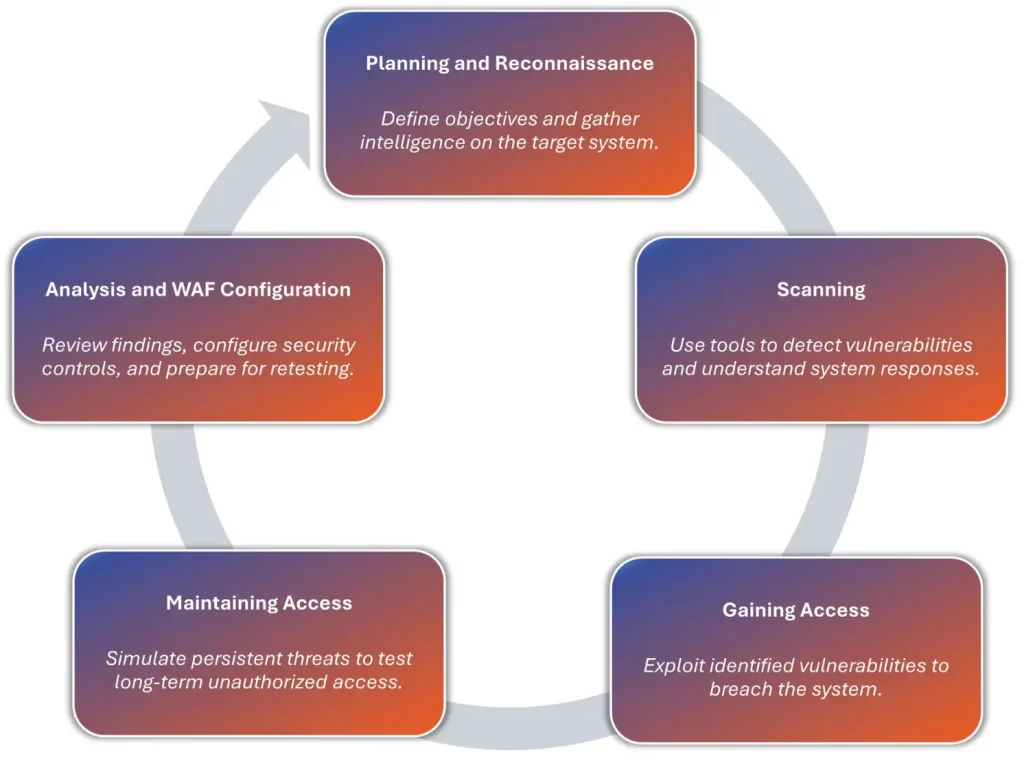
Vulnerability Assessment and Penetration Testing (VAPT) is a comprehensive security testing approach that combines automated scanning (vulnerability assessment) with simulated real-world attacks (penetration testing) to identify, evaluate, and validate security weaknesses in an organization’s IT infrastructure.
Vulnerability Assessment and Penetration Testing (VAPT) Lifecycle in Four Key Steps

Key Differences Between Vulnerability Assessment and Penetration Testing
Vulnerability Assessment and Penetration Testing serve different purposes within a security strategy. A vulnerability assessment is primarily focused on identifying and listing known security flaws across systems using automated tools. It provides a broad overview of potential weaknesses but does not exploit them. In contrast, penetration testing is a simulated attack that actively attempts to exploit vulnerabilities to determine how an attacker could gain unauthorized access or cause damage. While vulnerability assessments are ideal for regular, wide-scale scans, penetration testing offers deeper insight into real-world risks by mimicking actual threat scenarios. Together, they offer a balanced and effective approach to cybersecurity.
What is a Vulnerability Assessment?
A Vulnerability Assessment (VA) is a systematic process used to identify, quantify, and prioritize security weaknesses within an organization’s IT infrastructure. It helps organizations gain visibility into potential vulnerabilities in systems, networks, applications, and configurations before attackers can exploit them.
The goal of a vulnerability assessment is to proactively detect flaws that could be leveraged in cyberattacks, enabling businesses to address security gaps early in their lifecycle.
Key Components of a Vulnerability Management Program

- Asset Discovery : Identify all devices, systems, and applications in your environment.
- Vulnerability Scanning : Use tools to detect known security weaknesses and misconfigurations.
- Risk Assessment : Assign severity levels and prioritize vulnerabilities based on impact.
- Remediation and Mitigation : Apply patches or implement controls to fix or reduce risks.
- Verification (Re-scanning) : Confirm that issues have been resolved after remediation.
- Reporting and Metrics : Track progress, compliance, and vulnerability trends.
- Governance and Policy : Define roles, SLAs, and responsibilities for managing vulnerabilities.
- Continuous Monitoring : Regularly scans and adapts to new threats and changes in the environment.
What is a Penetration Test?
A penetration test (also known as pen test) is a simulated cyberattack performed by ethical hackers to actively exploit vulnerabilities in an organization’s systems, networks, or applications. The goal is to assess how well existing defenses can withstand real-world attacks and uncover security weaknesses before malicious actors do.
Unlike vulnerability assessments, which only detect and report potential issues, penetration testing goes a step further by attempting to breach systems to understand the actual risk.

Combining Vulnerability Assessments and Penetration Testing
By combining vulnerability assessments and penetration testing, you can achieve:
- A complete and accurate understanding of your organization’s security posture
- Faster identification and remediation of exploitable vulnerabilities
- Lower overall risk exposure across your digital assets
- A more efficient and proactive patch management workflow
In today’s threat landscape, relying on quarterly scans and annual pen tests is no longer enough to protect against modern cyber-attacks.
Which Security Policies are Essential for My Organization?
To ensure the effectiveness and long-term success of your security program, it’s essential to clearly document your vulnerability assessment and penetration testing processes.
Establishing formal policies as part of your security framework helps align your entire organization by clearly outlining expectations, responsibilities, and procedural requirements for maintaining a strong security posture.
Vulnerability Assessment Policy
This policy outlines how the organization identifies and manages security vulnerabilities.
Key Elements:
- Scope: All critical systems, applications, and networks.
- Frequency: Regular scans (e.g., monthly) and after major changes.
- Tools: Approved vulnerability scanners (e.g., Nessus, Qualys).
- Responsibilities: Security team performs scans and coordinates remediation.
- Risk Scoring: Based on CVSS or similar frameworks.
- Remediation: Prioritized by risk level with defined timelines.
- Reporting: Results shared with IT and leadership teams.
Penetration Testing Policy
This policy defines how simulated cyberattacks are conducted to evaluate security controls.
Key Elements:
- Purpose: Identify exploitable vulnerabilities and validate defenses.
- Scope: Internal and external systems, applications, and cloud environments.
- Frequency: At least annually or after significant system changes.
- Authorized Testers: Internal red team or third-party providers.
- Rules of Engagement: Predefined scope, timing, and impact limits.
- Remediation: Action plans created for all findings.
- Review: Post-test analysis and lessons learned integrated into security strategy.
How Reporting Differs Between Vulnerability Assessment and Penetration Testing:
| Aspect | Vulnerability Assessment | Penetration Testing |
| Purpose of Report | To list and categorize known vulnerabilities | To demonstrate how vulnerabilities can be exploited |
| Detail Level | Broad overview with technical findings | In-depth analysis of attack paths and exploitation techniques |
| Risk Scoring | Typically includes CVSS scores or severity ratings | Includes business impact and likelihood of successful attack |
| Remediation Guidance | General remediation steps or patch recommendations | Contextual and strategic fixes based on actual exploitation |
| Audience | IT administrators, compliance teams | Security teams, leadership, developers, risk managers |
| Format | Automated reports, often tool-generated | Manually written, narrative-style reports with screenshots/logs |
| Frequency | Regular (e.g., monthly/quarterly) | Periodic or event-driven (e.g., annually or after major updates) |
| Focus | Detection and prioritization of known issues | Real-world attack simulation and security control validation |
VAPT in 2025: Evolving Cybersecurity for Modern Threats
Vulnerability Assessment and Penetration Testing (VAPT) in 2025 has evolved into a dynamic and continuous security strategy designed to keep pace with increasingly sophisticated cyber threats, hybrid IT environments, and complex compliance requirements.
Unlike traditional, one-time assessments, modern VAPT programs now integrate automation, AI-driven threat intelligence, and real-time remediation workflows to provide continuous visibility and validation of an organization’s security posture.
Key Benefits of VAPT in 2025
Continuous Risk Visibility
Real-time vulnerability assessments and on-demand penetration testing provide constant awareness of evolving threats.
Faster Remediation Cycles
Automated scans and integrated workflows reduce the time between detection and resolution of security issues.
Protection Across Modern Environments
VAPT extends to cloud platforms, APIs, containers, and remote endpoints—securing hybrid and decentralized IT landscapes.
AI-Driven Threat Prioritization
Advanced analytics help focus on the vulnerabilities that pose the greatest business risk, not just those with high severity scores.
Integrated DevSecOps Support
Embedding VAPT into CI/CD pipelines ensures vulnerabilities are detected and fixed early in the software development lifecycle.
Regulatory and Compliance Readiness
Continuous testing aligns with evolving standards like PCI DSS v4.0, ISO 27001:2022, GDPR, and industry-specific mandates.
Real-World Threat Validation
Penetration testing simulates actual attack scenarios, helping validate whether existing defenses can prevent or detect breaches.
Reduced Attack Surface
Proactively identifies weak points across systems and applications, minimizing exploitable entry points for attackers.
Strategic Security Investment
Helps organizations prioritize remediation efforts and security spending based on validated risk, not guesswork.
Unlock the Value of Progressive Infotech’s VAPT Services
Progressive Infotech’s Vulnerability Assessment and Penetration Testing (VAPT) services offer a comprehensive, strategic approach to identifying and mitigating security vulnerabilities across your IT infrastructure. By blending automated scanning with in-depth, expert-driven penetration testing, we uncover more than just surface-level threats—delivering deep insights into real-world risks, validating potential attack vectors, and prioritizing fixes based on their impact to your business.
Our seasoned security professionals specialize in cloud, on-premises, and hybrid environments, ensuring that vulnerabilities are detected early and addressed proactively. This strengthens your compliance posture, minimizes your exposure to cyber threats, and empowers your digital transformation initiatives with confidence and resilience.
Product: VAPT
Contact Us to learn how we can help secure your digital ecosystem